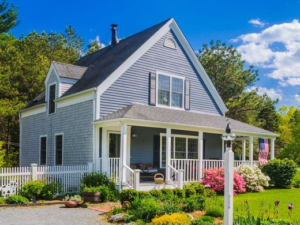A lot goes into the construction of a single-family home!
Last year we included a news post on the number of trees that are required to build a single family home in the U.S.. There was s a lot of interest in the post and it continues to be quite active. This got me thinking about the many other components in the home. In 2017 the average new single-family American home topped 2,660 square-foot. As you will see, there are many, many parts needed for a house this size, and a lot of time, money and energy is expended. The carbon footprint for building a home from scratch is large.

Here is a breakdown on some of the materials that must be manufactured, mined or logged for constructing it:
-
Lumber:
16,380 board-feet of framing lumber. The equivalent of twenty two 60+ year old trees. (45 trees if you include the sheathing, roofing and exterior siding below.)
-
Plywood:
7,573 square feet of material including roof, wall, shear and floor sheathing.
-
Concrete and cement:
86 cubic yards of concrete.
-
Siding and exterior:
3,944 square feet of exterior finish. This could be wood, stucco/" target="_blank" rel="noopener noreferrer">stucco, steel, aluminum, stone, brick, shingles, composite planks etc. or a combination of the above.
-
Roofing:
3,107 square feet of material. Asphalt, composite, tile, wood shingles, slate or metal.
-
insulation/" target="_blank" rel="noopener noreferrer">Insulation:
3,900 square feet of insulation, mostly in the form of fiberglass batts.
-
Drywall and sheetrock:
10,115 square feet of ½”gypsum wall board and some cement backer board.
-
Ducting and air:
135-150 linear feet of fiberglass insulated air ducting.
-
Paint and coatings:
129 gallons of primer and finish paint materials. Newer formulas require more coats on average than before.
-
Nails, hardware and connectors:
470-600 pounds of steel nails and other metal fasteners. California requires additional heavier seismic reinforcements hardware.
-
Wiring and electrical:
1,500-1,800 feet of copper electrical wiring.
-
Electrical fittings:
200 plus individual electrical components comprised of switches/outlets/boxes/panels
-
Water pipe and plumbing-systems/" target="_blank" rel="noopener noreferrer">plumbing:
490 linear feet of copper or plastic water piping and supply lines plus 150 copper or plastic plumbing fittings.
-
Sewer and vents:
270 feet of plastic ABS type pipe for drain, waste and vent piping, plus 110 ABS sewer/vent fittings.
-
Windows and glass:
22 operable windows with 372sft of insulated glass units.
-
Doors:
15 interior doors; 6 exterior doors, a double-wide garage door and 2 sliding glass doors.
-
Bathtubs:
2 bathtub/showers and 1 shower stall.
-
Cabinets:
32 kitchen cabinets with doors and drawers.
-
Appliances:
1 range, 1 range hood, 1 refrigerator, 1 dishwasher, 1 garbage disposal, 1 microwave, 4 smoke detectors, 2 CO detectors, 1 garage door operator.
-
Electrical finishes:
35 Light fixtures.
-
Plumbing finishes:
30 Plumbing fixtures and 1 50-gallon tank water heater.
-
Heating and cooling systems:
2 forced air furnaces with air conditioner units and outdoor compressors.
-
Flooring materials:
2,100 square feet of carpet, 500 square feet of vinyl.
-
Labor:
2,085 man/hours on site, 400/hours office, 2800/hours indirect and off-site.
-
Carbon footprint:
During the building of the home, approximately 125 tons of carbon are produced including site preparation. This is a large footprint. Learn about carbon footprints of remodel vs new home construction.
-
Projected life:
65 years.
Summary
A sixty five year projected life is not sustainable. There are many parts to a home but much of the structure could have a longer life. There is no reason why a home built to code in the United States could not last hundreds of years with maintenance-and-repair-strategy/" target="_blank" rel="noopener noreferrer">appropriate maintenance and timely renovations to systems. Planning ahead for the inevitable updating of infrastructure items that wear out or are overtaken by superior technologies, like finishes, plumbing, roofing, electrical services, and HVAC equipment would extend the life indefinitely.
It could be done.








